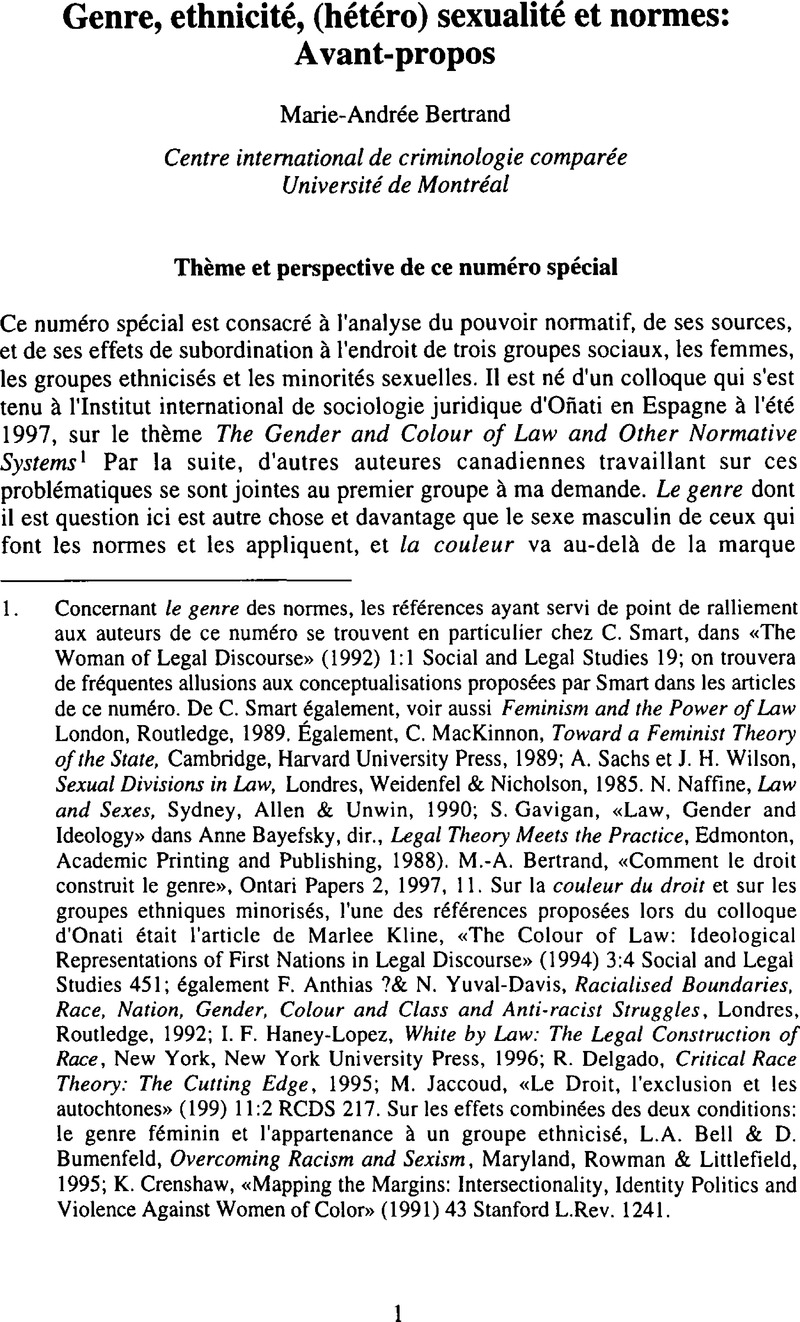Article contents
Genre, ethnicité, (hétéro) sexualité et normes: Avant-propos
Published online by Cambridge University Press: 18 July 2014
Abstract

- Type
- Articles
- Information
- Copyright
- Copyright © Canadian Law and Society Association 1999
References
1. Concernant le genre des normes, les références ayant servi de point de ralliement aux auteurs de ce numéro se trouvent en particulier chez Smart, C., dans «The Woman of Legal Discourse» (1992) 1:1Social and Legal Studies 19CrossRefGoogle Scholar; on trouvera de fréquentes allusions aux conceptualisations proposées par Smart dans les articles de ce numéro. Smart, De C. également, voir aussi Feminism and the Power of Law London, Routledge, 1989.CrossRefGoogle Scholar Également, MacKinnon, C., Toward a Feminist Theory of the State, Cambridge, Harvard University Press, 1989Google Scholar; Sachs, A. et Wilson, J. H., Sexual Divisions in Law, Londres, Weidenfei & Nicholson, 1985.Google ScholarNaffine, N., Law and Sexes, Sydney, Allen & Unwin, 1990Google Scholar; Gavigan, S., «Law, Gender and Ideology» dans Bayefsky, Anne, dir., Legal Theory Meets the Practice, Edmonton, Academic Printing and Publishing, 1988).Google Scholar M.-A. Bertrand, «Comment le droit construit le genre», Ontari Papers 2, 1997, 11. Sur la couleur du droit et sur les groupes ethniques minorisés, l'une des références proposées lors du colloque d'Onati était l'article de Kline, Marilee, «The Colour of Law: Ideological Representations of First Nations in Legal Discourse» (1994) 3:4Social and Legal Studies 451CrossRefGoogle Scholar; également Anthias, F. & Yuval-Davis, N., Racialised Boundaries, Race, Nation, Gender, Colour and Class and Anti-racist Struggles, Londres, Routledge, 1992Google Scholar; Haney-Lopez, I. F., White by Law: The Legal Construction of Race, New York, New York University Press, 1996Google Scholar; Delgado, R., Critical Race Theory: The Cutting Edge, 1995Google Scholar; Jaccoud, M., «Le Droit, l'exclusion et les autochtones» (199) 11:2RCDS 217.Google Scholar Sur les effets combinées des deux conditions: le genre féminin et l'appartenance à un groupe ethnicisé, Bell, L.A. & Bumenfeld, D., Overcoming Racism and Sexism, Maryland, Rowman & Littlefield, 1995Google Scholar; Crenshaw, K., «Mapping the Margins: Intersectionality, Identity Politics and Violence Against Women of Color» (1991) 43 Stanford L.Rev. 1241.CrossRefGoogle Scholar
2. Les oeuvres récentes qui théorisent les rapports du droit avec les minorités sexuelles surabondent. Voir par exemple Strychin, C. F., Law's Desire: Sexuality and the Limits of Justice, New York, Routledge, 1995Google Scholar; Moran, J. L., The Homosexual(ity) of Law, New York, Routledge, 1996CrossRefGoogle Scholar; Herman, D. & Strychin, C., dir., Legal Inversions, Gay Men and the Politics of Law, Philadelphie, Temple University Press, 1995.Google Scholar
3. Sur la perspective constructiviste, voir l'oeuvre capitale de Berger, P. et Luckmann, T. à laquelle réfèrent plusieurs auteurs travaillant en sociologie du droit, The Social Construction of Reality, Anchor, 1967Google Scholar; Teubner, G., «Pour une épistémologie constructiviste du droit» (1994) LGDJ 171Google Scholar, où l'auteur s'appuie précisément sur Berger et Luckmann pour analyser le travail de Foucault, Habermas et Luhmann sur le droit. Voir aussi Villa, V., «La science juridique entre descriptivisme et constructivisme» dans Amselek, P., dir., Théorie du droit et sur le droit, PUF, 1994, 288Google Scholar, qui réfère également à Berger et Luckmann. Sur le constructivisme appliqué aux rapports entre les femmes et le droit et traitant en particulier des modèles féminins entretenus par le droit, parmi plusieurs autres oeuvres, voir Sheldon, S., «Who Is the Mother to Make the Judgment? The Construction of Mother in the English Abortion Law» (1993) 1:1Feminist Legal Studies 3.CrossRefGoogle Scholar Sur l'épistémologie “standpoint” et la connaissance “située”, voir par exemple Haraway, D., «Situated Knowledges» (1988) 14:3Feminist Studies 575CrossRefGoogle Scholar; Hartsock, N., Money, Sex and Power, New York, Longman, 1983Google Scholar; Harding, S., Whose Power? Whose Knowledge? Thinking from Women's Lives, Ithaca, Cornell University Press, 1991.Google Scholar Récemment, voir dans Sassower, R. un commentaire de la proposition théorique de Haraway dans «The Politics of Situated Knowledge» (1994) 8:2185.Google Scholar Voir aussi Pels, D., «Standpoint Epistemology» (que l'auteur assimile au “situated knowledge”) dans (1998) 108 Telos 65.Google Scholar
4. Bertrand, M.-A., Biron, L.-L., Fagnan, A.-B., Di Pisa, C. et McNeil, J.: Prisons pour femmes, Montréal, Méridien, 1998.Google Scholar
- 1
- Cited by




